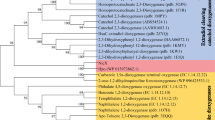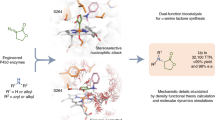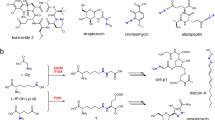Abstract
Peptide amidation is a ubiquitous posttranslational modification of bioactive peptides. Peptidylglycine α-hydroxylating monooxygenase (PHM; EC 1.14.17.3), the enzymne that catalyzes the first step of this reaction, is composed of two domains, each of which binds one copper atom. The coppers are held 11 Å apart on either side of a solvent-filled interdomain cleft, and the PHM reaction requires electron transfer between these sites. A plausible mechanism for electron transfer might involve interdomain motion to decrease the distance between the copper atoms. Our experiments show that PHM catalytic core (PHMcc) is enzymatically active in the crystal phase, where interdomain motion is not possible. Instead, structures of two states relevant to catalysis indicate that water, substrate and active site residues may provide an electron transfer pathway that exists only during the PHM catalytic cycle.
This is a preview of subscription content, access via your institution
Access options
Subscribe to this journal
Receive 12 print issues and online access
$189.00 per year
only $15.75 per issue
Buy this article
- Purchase on Springer Link
- Instant access to full article PDF
Prices may be subject to local taxes which are calculated during checkout








Similar content being viewed by others
References
Eipper, B.A., Stoffers, D.A. & Mains, R.E. The biosynthesis of neuropeptides: peptide alpha-amidation. Annu. Rev. Neurosci. 15, 57–85 (1992).
Eipper, B.A., Milgram, S.L., Husten, E.J., Yun, H-Y. & Mains, R.E. Peptidylglycine alpha-amidating monooxygenase: a multifunctional protein with catalytic, processing, and routing domains. Protein Sci. 2, 489–497 (1993).
Bradbury, A.F. & Smyth, D.G. Peptide amidation. TIBS 16, 112–115 (1991).
Merkler, D.J. C-terminal amidated peptides: production by the in vitro enzymatic amidation of glycine-extended peptides and the importance of the amide to bioactivity. Enzyme Microb. Technol. 16, 450–456 (1994).
Katopodis, A.G. & May, S.W. Novel substrates and inhibitors of peptidylglycine alpha-amidating monooxygenase. Biochemistry 29, 4541–4548 (1990).
Suzuki, K., Ohta, M., Okamoto, M. & Nishikawa, Y. Functional expression and characterization of a Xenopus laevis peptidylglycine alpha-amidating monooxygenase, AE-II, in insect-cell culture. Eur. J. Biochem. 213, 93–98 (1993).
Eipper, B.A., Quon, A.S.W., Mains, R.E., Boswell, J.S. & Blackburn, N.J. The catalytic core of peptidylglycine alpha-hydroxylating monooxygenase: investigation by site-directed mutagenesis, Cu x-ray absorption spectroscopy, and electron paramagnetic resonance. Biochemistry 34, 2857–2865 (1995).
Kulathila, R. et al. Bifunctional peptidylglycine alpha-amidating enzyme requires two copper atoms for maximum activity. Arch. Biochem. Biophys. 311, 191–195 (1994).
Freeman J.C., Villafranca, J.J. & Merkler, D.J. Redox cycling of enzyme-bound copper during peptide amidation. J. Am. Chem. Soc. 115, 4923–4924 (1993).
Prigge, S.T., Kolhekar, A.S., Eipper, B.A., Mains, R.E. & Amzel, L.M. Amidation of bioactive peptides: the structure of peptidylglycine alpha-hydroxylating monooxygenase. Science 278, 1300–1305 (1997).
Gray, H.B. & Winkler, J.R. Electron transfer in proteins. Annu. Rev. Biochem. 65, 537–561 (1996).
Moser, C.C., Page, C.C., Chen, X. & Dutton, P.L. Electron tunneling in proteins: role of the intervening medium. J. Biol. Inorg. Chem. 2, 393–398 (1997).
Beratan D. & Skourtis S. Electron transfer mechanisms. Curr. Opin. Chem. Biol. 2, 235–243 (1998).
Westbrook, E.M. & Sigler, P.B. Enzymatic function in crystals of delta 5-3-ketosteroid isomerase. Catalytic activity and binding of competitive inhibitors. J. Biol. Chem. 259, 9090–9095 (1984).
Merkler, D.J., Kulathila, R., Tamburini, P.P. & Young, S.D. Selective inactivation of the hydroxylase activity of bifunctional rat peptidylglycine alpha-amidating enzyme. Arch. Biochem. Biophys. 294, 594–602 (1992).
Champloy, F. et al. Studies of copper complexes displaying N3S coordination as models for CuB center of dopamine beta-hydrolase and peptidylglycine alpha-hydroxylating monooxygenase. Inorg. Chem. 37, 3910–3918 (1998).
Ramer, S.E., Cheng, H., Palcic, M.M. & Vederas, J.C. Formation of peptide amides by peptidylglycine alpha-amidating monooxygenase: a new assay and stereochemistry of hydrogen loss. J. Am. Chem. Soc. 110, 8526–8532 (1988).
Boswell, J.S., Reedy, B.J., Kulathila, R., Merkler, D. & Blackburn, N.J. Structural investigations on the coordination environment of the active-site copper centers of recombinant bifunctional peptidylglycine alpha-amidating enzyme. Biochemistry 35, 12241–12250 (1996).
Casella, L. & Gullotti, M. In Bioinorganic chemistry of copper. (eds Karlin, K.D. & Tyeklar, Z.) 292–305 (Chapman and Hall, New York; 1993).
Casella, L., Gullotti, M., Bartosek, M., Pallanza, G. & Laurenti, E. Model monooxygenase reactivity by binuclear two-coordinate copper(I) complexes extends to new ligand systems containing nitrogen and sulphur donors. J. Chem. Soc., Chem. Commun. 1235–1237 (1991).
Mehta, N.M. et al. Purification of a peptidylglycine alpha-amidating enzyme from transplantable rat medullary thyroid carcinomas. Arch. Biochem. Biophys. 261, 44–54 (1988).
Tamburini, P.P., Young, S.D., Jones, B.N., Palmesino, R.A. & Consalvo, A.P. Peptide substrate specificity of the alpha-amidating enzyme isolated from rat medullary thyroid CA-77 cells. Int. J. Pept. Protein Res. 35, 153–156 (1990).
Guss, J.M., Harrowell, P.R., Murata, M., Norris, V.A. & Freeman, H.C. Crystal structure analysis of reduced (CuI) poplar plastocyanin at six pH values. J. Mol. Biol. 192, 361–387 (1986).
Beratan, D.N., Betts, J.N. & Onuchic J.N. Protein electron transfer rates set by the bridging secondary and tertiary structure. Science 252, 1285 (1991).
Beratan, D. & Skourtis, S. Electron transfer mechanisms. Curr. Opin. Chem. Biol. 2, 235 (1998).
Qi, P.X., Urbauer, J.L., Fuentes, E.J., Leopold, M.F. & Wand, A.J. Structural water in oxidized and reduced horse heart cytochrome c. Nature Struct. Biol. 1, 378–382 (1994).
Sharp, K.A. Calculation of electron transfer reorganization energies using the finite difference Poisson–Boltzmann model. Biophys. J. 74, 1241–1250 (1998).
Kumar, K., Lin, Z., Waldeck, D.H. & Zimmt, M.B. Electronic coupling in C-clamp-shaped molecules in solvent-mediated superexchange pathways. J. Am. Chem. Soc. 118, 243–244 (1996).
Bradbury, A.F., Mistry, J., Roos, B.A. & Smyth, D.G. 4-phenyl-3-butenoic acid, an in vivo inhibitor of peptidylglycine hydroxylase (peptide amidating enzyme). Eur. J. Biochem. 189, 363–368 (1990).
Rhodes, C.H. & Honsinger, C. Structure-activity relationships among inhibitors of peptidylglycine amidating monooxygenase. Ann. N.Y. Acad. Sci. 689, 663–666 (1993).
Casara, P., Ganzhorn, A., Philippo, C., Chanal, M-C. & Danzin, C. Unsaturated thioacetic acids as novel mechanism-based inhibitors of peptidylglycine alpha-hydroxylating monooxygenase. Bioorg. Med. Chem. Lett. 6, 393–396 (1996).
Merkler, D.J., Merkler, K.A., Stern, W. & Fleming, F.F. Fatty acid amide biosynthesis: a possible new role for peptidylglycine alpha-amidating enzyme and acyl-coenzyme A:glycine N-acyltransferase. Arch. Biochem. Biophys. 330, 430–434 (1996).
Bolkenius, F.N., Ganzhorn, A.J., Chanal, M-C. & Danzin, C. Selective mechanism-based inactivation of peptidylglycine alpha-hydroxylating monooxygenase in serum and heart atrium vs. brain. Biochem. Pharmacol. 53, 1695–1702 (1997).
Bradbury, A.F. & Smyth, D.G. In Biogenetics of neurohormonal peptides. (eds Hakanson, R. & Thorell, J.) 171–186 (New York; Academic; 1985).
Murthy A.S., Keutmann H.T. & Eipper B.A. Further characterization of peptidylglycine alpha-amidating monooxygenase from bovine neurointermediate pituitary. Mol. Endocrinol. 1, 290–299 (1987).
Karlin, K.D., Kaderli, S. & Zuberbuhler, A.D. Kinetic and thermodynamics of copper(I)/dioxygen interaction. Acc. Chem. Res. 30, 139–147 (1997).
Ahn, N. & Klinman, J.P. Mechanism of modulation of dopamine beta-monooxygenase by pH and fumarate as deduced from initial rate and primary deuterium isotope effect studies. Biochemistry 22, 3096–3106 (1983).
Miller, S.M. & Klinman, J.P. Secondary isotope effects and structure-reactivity correlations in the dopamine beta-monooxygenase reaction: evidence for a chemical mechanism. Biochemistry 24, 2114–2127 (1985).
Tian, G., Berry, J.A. & Klinman, J.P. Oxygen-18 kinetic isotope effects in the dopamine beta-monooxygenase reaction: evidence for a new chemical mechanism in non-heme metallomonooxygenases. Biochemistry 33, 226–234 (1994).
Klinman, J.P. Mechanisms whereby mononuclear copper proteins functionalize organic substrates. Chem. Rev. 96, 2541–2561 (1996).
Eipper, B.A. & Mains, R.E. Peptide alpha-amidation. Annu. Rev. Physiol. 50, 333–344 (1988).
Stewart, L.C. & Klinman, J.P. Dopamine beta-hydroxylase of adrenal chromaffin granules: structure and function. Annu. Rev. Biochem. 57, 551–592 (1988).
Southan, C. & Kruse, L.I. Sequence similarity between dopamine beta-hydroxylase and peptide alpha-amidating enzyme: evidence for a conserved catalytic domain. FEBS Lett. 255, 116–120 (1989).
Francisco, W.A., Merkler, D.J., Blackburn, N.J. & Klinman, J.P. Kinetic mechanism and intrinsic isotope effects for the peptidylglycine alpha-amidating enzyme reaction. Biochemistry 37, 8244–8252 (1998).
Bernhard, P. & Anson, F.C. Hydrogen abstraction from amine complexes of Iron(II), Cobalt(I), and Ruthenium(II) by superoxide. Influence of driving force on rate. Inorg. Chem. 27, 4574–4577 (1988).
Vasquez-Vivar, J. et al. Superoxide generation by endothelial nitric oxide synthase: the influence of cofactors. Proc. Natl. Acad. Sci. USA 95, 9220–9225 (1998).
Poulos, T.L. & Raag, R. Cytochrome P450cam: crystallography, oxygen activation, and electron transfer. FASEB J. 6, 674–679 (1992).
Daff, S.N. et al. Redox control of the catalytic cycle of flavocytochrome P450 BM3. Biochemistry 36, 13816–13823 (1997).
Lanzilotta, W.N., Parker, V.D. & Seefeldt, L.C. Electron transfer in nitrogenase analyzed by Marcus theory: evidence for gating by MgATP. Biochemistry 37, 399–407 (1998).
Kolhekar, A.S., Keutmann, H.T., Mains, R.E., Quon, A.S.W. & Eipper, B.A. Peptidylglycine alpha-hydroxylating monooxygenase: active site residues, disulfide linkages, and a two-domain model of the catalytic core. Biochemistry 36, 10901–10909 (1997).
Otwinowski, Z. & Minor, W. Processing of X-ray diffraction data in oscillation mode. Methods Enzymol. 276, 307–326 (1997).
Brunger, A.T. X-PLOR version 3.1: a system for X-ray crystallography and NMR (Yale Univ. Press, New Haven; 1992).
Jones, T.A., Zou, J.-Y., Cowan, S.W. & Kjeldgaard, M. Improved methods for building protein models in electron density maps and the location of errors in these models. Acta Crystallogr. A 47, 110–119 (1991).
Zabriskie, T.M., Cheng, H. & Vederas, J.C. Incorporation of oxygen into the hydroxyglycyl intermediate during formation of C-terminal peptide amides by peptidylglycine alpha-amidating monooxygenase (PAM). J. Chem. Soc., Chem. Commun., 571–572 (1991).
Evans, S.V. SETOR: Hardware-lighted three-dimensional solid model representations of macromolecules. J. Mol. Graph. 11, 134–138 (1993).
Reedy, B.J. & Blackburn, N.J. Preparation and characterization of half-apo dopamine beta-hydroxylase by selective removal of CuA. Identification of a sulfur ligand at the dioxygen binding site by EXAFS and FITR spectroscopy. J. Am. Chem. Soc. 116, 1924–1931 (1994).
Harata, M., Jitsukawa, K., Masuda, H. & Einaga, H. A structurally characterized mononuclear copper(II)-superoxo complex. J. Am. Chem. Soc. 116, 10817–10818 (1994).
Acknowledgements
We thank C. Ogata and the staff at beamline X4A for assistance during data collection at the NSLS. Beamline X4A at the NSLS, a DOE facility, is supported by the Howard Hughes Medical Institute. We thank J. Berg, J. Wehrle and N. Carrasco for critical review of this manuscript. This work was supported by grants from the NIDDK to B.A.E and the NIGMS to L.M.A.
Author information
Authors and Affiliations
Corresponding author
Rights and permissions
About this article
Cite this article
Prigge, S., Kolhekar, A., Eipper, B. et al. Substrate-mediated electron transfer in peptidylglycine α-hydroxylating monooxygenase. Nat Struct Mol Biol 6, 976–983 (1999). https://doi.org/10.1038/13351
Received:
Accepted:
Issue Date:
DOI: https://doi.org/10.1038/13351
This article is cited by
-
An intramolecular macrocyclase in plant ribosomal peptide biosynthesis
Nature Chemical Biology (2024)
-
Ripping and stitching with copper
Nature Chemical Biology (2024)
-
Novel insights into peptide amidation and amidating activity in the human circulation
Scientific Reports (2021)
-
Effects of copper occupancy on the conformational landscape of peptidylglycine α-hydroxylating monooxygenase
Communications Biology (2018)
-
Coordination of peroxide to the CuM center of peptidylglycine α-hydroxylating monooxygenase (PHM): structural and computational study
JBIC Journal of Biological Inorganic Chemistry (2013)



